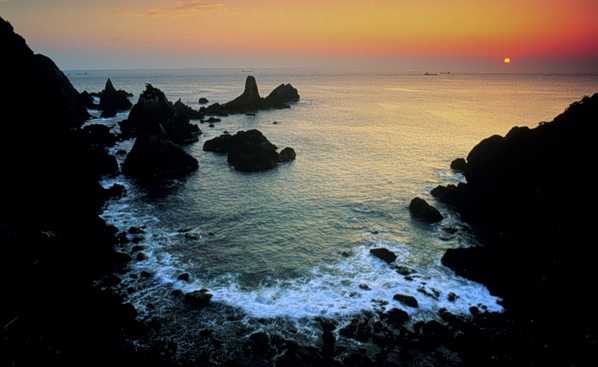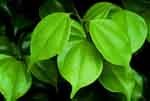
The stories of Kumano - Jofuku

The stories of Kumano - Jofuku
 Jofuku,
pronounced Xifu in Chinese, came to Japan during the
Jomon Era in the 3rd century B.C. It is said that he
landed near Shingu and brought with him much Chinese
culture and technology.
Jofuku,
pronounced Xifu in Chinese, came to Japan during the
Jomon Era in the 3rd century B.C. It is said that he
landed near Shingu and brought with him much Chinese
culture and technology.  Jofuku
was at the time serving as a Taoist shaman to the Emperor
Shikoutei of the Xin Dynasty in China about 2200 years
ago. He was ordered by the emperor to set out in order to
'find the elixir of eternal life which is said to be on
the mountain of Horai on the sea to the east'. He
eventually arrived in Kumano and with him he brought
about 3000 people, men, women, and children.
Unfortunately for the emperor he never returned to China.
The picture here shows the time of their landing. Jofuku
is in the middle of the front row and behind him you can
see a lot of the children who came with him.
Jofuku
was at the time serving as a Taoist shaman to the Emperor
Shikoutei of the Xin Dynasty in China about 2200 years
ago. He was ordered by the emperor to set out in order to
'find the elixir of eternal life which is said to be on
the mountain of Horai on the sea to the east'. He
eventually arrived in Kumano and with him he brought
about 3000 people, men, women, and children.
Unfortunately for the emperor he never returned to China.
The picture here shows the time of their landing. Jofuku
is in the middle of the front row and behind him you can
see a lot of the children who came with him.
to the top
 It was this
coastline which first welcomed Jofuku and his party after
their long voyage. Surely they must have felt the
'healing' power of Kumano as they arrived in this land of
warmth and scenic beauty where the Black Current runs
nearest to the land.
It was this
coastline which first welcomed Jofuku and his party after
their long voyage. Surely they must have felt the
'healing' power of Kumano as they arrived in this land of
warmth and scenic beauty where the Black Current runs
nearest to the land.  Although
various legends about Jofuku are found all over Japan,
his tomb is found only in Kumano. Jofuku's grave is
well-known to the citizens of Shingu City. Jofuku,
instead of going back to China, spent the rest of his
life in Kumano. His grave is in the east of Shingu City,
which has a market nearby bustling with shoppers from the
early morning on. The tombstone was built by order of
Tokugawa Yorinobu, the lord of Kishu. Next to it, under
the shade of a Tendai Uyaku plant and a big camphor tree,
lies a monument of the 'seven disciples' which honours
Jofuku's seven senior retainers. Recently, this site has
been designated as 'Jofuku Memorial Park' complete with a
Chinese style gate, where a memorial festival is now held
every August.
Although
various legends about Jofuku are found all over Japan,
his tomb is found only in Kumano. Jofuku's grave is
well-known to the citizens of Shingu City. Jofuku,
instead of going back to China, spent the rest of his
life in Kumano. His grave is in the east of Shingu City,
which has a market nearby bustling with shoppers from the
early morning on. The tombstone was built by order of
Tokugawa Yorinobu, the lord of Kishu. Next to it, under
the shade of a Tendai Uyaku plant and a big camphor tree,
lies a monument of the 'seven disciples' which honours
Jofuku's seven senior retainers. Recently, this site has
been designated as 'Jofuku Memorial Park' complete with a
Chinese style gate, where a memorial festival is now held
every August.  This plant
which is called 'Tendai Uyaku' is said to be the plant
which Jofuku succeeded in gathering after searching in
the Horai Mountain area. This plant is of the camphor
family and naturally grows in the mountains of Kumano. It
does not guarantee eternal life, but its root is used as
a potent medicine for kidney disease and rheumatism. This
plant is now made into 'Jofuku tea' and 'Jofuku wine'.
This plant
which is called 'Tendai Uyaku' is said to be the plant
which Jofuku succeeded in gathering after searching in
the Horai Mountain area. This plant is of the camphor
family and naturally grows in the mountains of Kumano. It
does not guarantee eternal life, but its root is used as
a potent medicine for kidney disease and rheumatism. This
plant is now made into 'Jofuku tea' and 'Jofuku wine'.  Jofuku no Miya
is the shrine named after the Chinese explorer Jofuku who
came in search of the elixir of immortality at the behest
of his Emperor. According to legend Jofuku did not return
to China but chose to remain in Kumano. It is believed
that it was Jofuku who brought Chinese culture and
technology to the region. Hence Chinese methods of
farming, fishing, whaling, papermaking, and so on became
widespread here and elsewhere in Japan. At that time
Kumano was a key location for bringing the culture of the
outside world to the inner reaches of Japan, being
situated as it was along important sea routes. These sea
routes were the main channels of communication and trade with the rest of the world
and were important in the history of Japan's development
and opening up to the world.
Jofuku no Miya
is the shrine named after the Chinese explorer Jofuku who
came in search of the elixir of immortality at the behest
of his Emperor. According to legend Jofuku did not return
to China but chose to remain in Kumano. It is believed
that it was Jofuku who brought Chinese culture and
technology to the region. Hence Chinese methods of
farming, fishing, whaling, papermaking, and so on became
widespread here and elsewhere in Japan. At that time
Kumano was a key location for bringing the culture of the
outside world to the inner reaches of Japan, being
situated as it was along important sea routes. These sea
routes were the main channels of communication and trade with the rest of the world
and were important in the history of Japan's development
and opening up to the world.  There are
various legends about Jofuku having visited all over
Japan. This stone monument deifying Jofuku is found in
Jofuku Memorial Park in Shingu City in Wakayama
Prefecture. Jofuku and the 3000 Taoist men, women, and
children who migrated to Japan had a truly epochal impact
on Japanese culture. At the time of Jofuku's arrival,
Japan was still in the Stone Age.
There are
various legends about Jofuku having visited all over
Japan. This stone monument deifying Jofuku is found in
Jofuku Memorial Park in Shingu City in Wakayama
Prefecture. Jofuku and the 3000 Taoist men, women, and
children who migrated to Japan had a truly epochal impact
on Japanese culture. At the time of Jofuku's arrival,
Japan was still in the Stone Age.